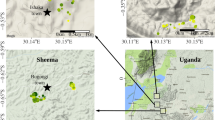Abstract
Recent changes in the area of the Plan Chontalpa in Tabasco have greatly reduced the production of subsistence crops by rural families, resulting in decreased crop diversity and a concomitant increase in the degree of dependence on outside sources of food. Results from a nutrition survey of 149 families demonstrate that dietary diversity, dietary quality, and nutritional status of preschool children are negatively associated with lower crop diversity and increased dependence on purchased foods. Dietary deterioration is illustrated by the negative relationship found between nutritional status and increased sugar consumption. The assumption that a rise in income accompanying the adoption of commercial production will automatically lead to improved nutrition is challenged: income levels were not found to be consistently related to nutritional status. Children of families that have converted to cattle production, despite greater land availability and family incomes, do not have improved nutritional status. In the study area, where wages are low and food prices are very high, the value of a higher degree of self-sufficiency in food is recognized, yet families continue to switch to cash crops due to the environmental, economic, and time constraints imposed by the system of commercial agriculture in which they participate. The solution is not to return to traditional subsistence farming, however, but to determine under what conditions a more progressive form of agricultural change can occur.
Similar content being viewed by others
References
Beaudry-Darisme, M. N., Hayes-Blend, L. C., and Van Veen, A. G. (1972). The application of sociological research methods to food and nutrition problems on a Caribbean island.Ecology of Food and Nutrition 1: 103–119.
Dewey, K. G. (1979). Agricultural development, diet and nutrition.Ecology of Food and Nutrition 8: 265–273.
Dewey, K. G. (1980a).The Ecology of Agricultural Change and Child Nutrition: A Case Study in Southern Mexico. PhD dissertation, Univ. of Michigan.
Dewey, K. G. (1980b). The impact of agricultural development on child nutrition in Tabasco, Mexico.Medical Anthropology 4(1): 21–54.
Fleuret, P., and Fleuret, A. (1980). Nutrition, consumption, and agricultural change.Human Organization 39(3): 250–260.
Garn, S. M., Larkin, F. A., and Cole, P. E. (1978). The real problem with 1-day diet records.American Journal of Clinical Nutrition 31(7): 1114–1116.
Gross, D., and Underwood, B. (1971). Technological change and caloric costs: sisal agriculture in Brazil.American Anthropology 73: 725–740.
Gudeman, S. (1978).The Demise of a Rural Economy: From Subsistence to Capitalism in a Latin American Village. Routledge & Kegan Paul, London.
Hernandez, M., Hidalgo, C. P., Hernandez, J. R., Madrigal, H., and Chavez, A. (1974). Effect of economic growth on nutrition in a tropical community.Ecology of Food and Nutrition 3: 283–291.
Hernandez, M., Chavez, A., and Bourges, H. (1977).Valor Nutritivo de los Alimentos Mexicanos. Instituto Nacional de la Nutrición, Mexico.
Krebs, C. J. (1972).Ecology. Harper and Row, New York.
Marchione, T. J. (1977). Food and nutrition in self-reliant national development: The impact on child nutrition of Jamaican government policy.Medical Anthropology 1: 57–79.
Palmer, I. (1974). The social and economic implications of large-scale introduction of new varieties of foodgrain: Summary of conclusions of a global project. (United Nations Research Institute for Social Development)
Pearse, A. (1975).The Latin American Peasant. Frank Cass, London.
Ramos Galvan, R. (Ed.) (1975). Somatometrfa pediátrica estudio semilongitudinal en ni¯nos de la ciudad de México.Archivos de Investigacibn Médica 6 (Suppl. 1).
Stavenhagen, R. (1978). Capitalism and the peasantry in Mexico.Latin American Perspectives 18(V) (3): 27–37.
Stavrakis, O., and Marshall, M. L. (1978). Women, agriculture and development in the Maya lowlands: Profit or progress. Paper presented at a conference on Women and Food, January 1978, Tucson, Arizona.
Taussig, M. (1978). Peasant economics and the development of capitalist agriculture in the Cauca Valley, Colombia.Latin American Perspectives 18(V) (3): 62–90.
Teitelbaum, J. (1977). Human versus animal nutrition: A “development” project among Fulani cattlekeepers of the Sahel of Senegal. In Fitzgerald, T. (Ed.),Nutrition and Anthropology in Action. Van Gorcum, Assen.
Ulloa, M. (1974). Mycofloral succession inpozol from Tabasco, Mexico.Bol. Soc. Mex. Mic. 8: 17–48.
Wasserstrom, R. (1978). Population growth and economic development in Chiapas, 1524–1975.Human Ecology 6(2): 127–143.
Author information
Authors and Affiliations
Rights and permissions
About this article
Cite this article
Dewey, K.G. Nutritional consequences of the transformation from subsistence to commercial agriculture in Tabasco, Mexico. Hum Ecol 9, 151–187 (1981). https://doi.org/10.1007/BF00889132
Issue Date:
DOI: https://doi.org/10.1007/BF00889132




